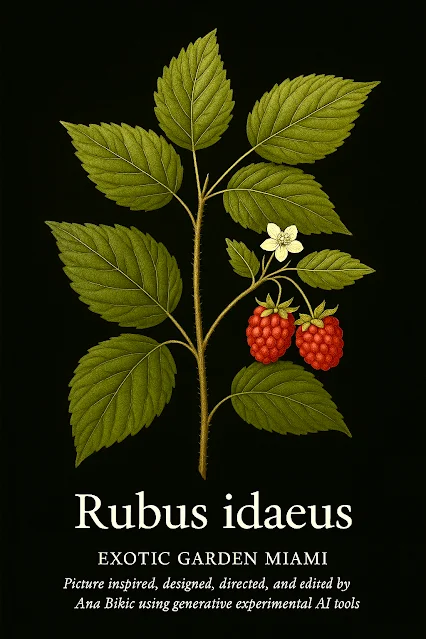 |
| Raspberry Rubus Idaeus Plant Care Exotic Garden Florida Fruits |
Check the Complete List of Plants, Trees, Ornamental and Medicinal Plants
Raspberry Plant – Rubus Idaeus
Also Known As: Red Raspberry, European Raspberry, Frambuesa
🌍 Place Of Origin
The raspberry plant (Rubus idaeus) originates from Europe and Northern Asia, particularly the cool-temperate forests of Eastern Europe and the Caucasus region. It has been cultivated since antiquity for its sweet, nutrient-rich fruits and medicinal properties. The species was widely spread through Europe and introduced to North America by European settlers, where it hybridized with native species.
🌱 USDA Growing Zones
-
Ideal Zones: 3–9, depending on variety
-
In South Florida (Zone 10–11), traditional raspberries struggle due to heat and humidity. However, some heat-tolerant varieties like ‘Dorman Red’ or ‘Mysore Raspberry’ (a black raspberry) may grow with care and partial shade.
🌿 Soil & Water Requirements
-
Soil: Loamy, well-drained, slightly acidic (pH 5.5–6.5)
-
Enrich with organic compost and ensure good drainage to prevent root rot
-
Water: Needs consistent moisture, especially during flowering and fruiting
-
Avoid overwatering; drip irrigation is ideal to keep foliage dry and prevent fungal issues
🌞 Light & Temperature
-
Light: Full sun preferred, though partial shade can help in hot climates like Florida
-
Temperature Range: 60–75°F is ideal for fruiting; cool winters help trigger better flowering in spring
-
Heat Stress: In Florida, raspberries may struggle unless shaded and protected from intense heat
✂️ Care & Pruning
-
Support: Use trellises or stakes to support canes and keep fruit off the ground
-
Pruning: Remove old canes after fruiting (biennial varieties); regular thinning improves airflow and yield
-
Mulching: Helps retain moisture and suppress weeds
🍓 Fruit Nutritional Value
Raspberries are rich in fiber, antioxidants, and essential vitamins, making them a true superfood.
Key Nutrients:
-
Vitamin C – Supports immunity and skin health
-
Vitamin K – Important for blood clotting and bone health
-
Manganese – Aids metabolism and antioxidant function
-
Fiber – Promotes digestive health and satiety
-
Ellagic Acid – A powerful antioxidant studied for anti-cancer properties
-
Anthocyanins – Pigments that help reduce inflammation and oxidative stress
🧪 Health Benefits & Lab Studies
-
Anti-Cancer: Multiple studies suggest that raspberry compounds (especially ellagic acid and anthocyanins) may inhibit tumor growth and slow the proliferation of cancer cells
-
Study: “Ellagic Acid and Raspberry Extracts Suppress Tumor Cell Proliferation” – Journal of Nutrition (2004)
-
-
Heart Health: High levels of polyphenols may help lower blood pressure and cholesterol
-
Diabetes Support: Low glycemic index and high fiber help regulate blood sugar levels
-
Brain Health: Antioxidants may reduce cognitive decline associated with aging
🍃 Raspberry Leaves – Medicinal Properties
Raspberry leaves are highly valued in herbal medicine, especially in traditional European and Indigenous practices.
Nutritional & Medicinal Components:
-
Tannins: Astringent compounds that help tone tissues
-
Flavonoids: Anti-inflammatory and antioxidant properties
-
Fragarine: An alkaloid thought to strengthen uterine muscles
Herbal Uses:
-
Raspberry Leaf Tea is commonly used to:
-
Relieve menstrual cramps and regulate cycles
-
Support labor and delivery (traditional midwifery use)
-
Ease gastrointestinal discomfort
-
Provide a mineral-rich tonic (high in iron, calcium, magnesium)
-
-
Often used in blends for women’s reproductive health
⚠️ Note: Pregnant women should consult a health provider before using raspberry leaf, especially in early pregnancy.
🏺 Cultural & Historical Significance
-
In European folklore, raspberries were considered a symbol of kindness and maternal love
-
Used by the Ancient Greeks and Romans for both food and medicine
-
Native American tribes used both berries and leaves for food and healing teas
-
Raspberry leaf has long been known as a “women’s herb” in Western herbal traditions
🐶 Toxicity
-
Non-Toxic To Humans And Pets
-
Berries and leaves are safe for consumption
-
Dogs and cats can eat small amounts of fruit, though excessive amounts may cause minor digestive upset
🌺 Landscape Tips
-
Best grown in cooler or shaded parts of a tropical garden in Florida
-
Choose heat-tolerant or everbearing varieties like ‘Dorman Red’
-
Keep away from high-traffic areas—thorny canes can snag clothing or skin
-
Perfect for edible hedgerows, raised beds, or permaculture gardens
✅ Summary
The Raspberry Plant is not only a delicious fruit-bearing shrub but a nutritional powerhouse and time-tested medicinal herb. While challenging to grow in South Florida, success is possible with the right variety, soil, and shade. Both the fruit and leaves offer impressive health benefits, supported by modern scientific research and centuries of traditional use. If cultivated with care, raspberries can become a rewarding part of a subtropical food garden.
The Raspberry Plant (Rubus idaeus) with a focus on its place of origin, growing zones, soil and water needs, health benefits (including leaves), scientific studies, and cultural significance, especially tailored for readers interested in gardening, nutrition, and herbal medicine:

Comments
Post a Comment